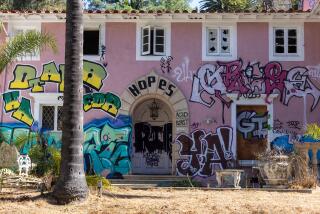Hats Off to Derby House : The landmark home in Glendale was designed by Lloyd Wright, son of Frank Lloyd Wright, and built in 1926.
- Share via
GLENDALE — The Derby House is a child’s dream castle--stacks of dark blocks reaching skyward. Its hulk is enshrouded in foliage. Its facade is massive and forbidding. One half-expects Mayan ghosts to surge from its bowels, spears outstretched in greeting.
Lloyd Wright, the son of Frank Lloyd Wright, built the house in 1926 for businessman James Derby, his wife and two sons. The Derbys separated prior to the home’s completion; only Mrs. Derby and the children eventually lived within its mysterious walls.
The Derby House’s rock-pile form is dauntingly archetypal. It resembles the ancient fortresses and temples erected centuries ago in Cambodia, India, Indonesia, Mexico and medieval Europe. These structures seemed to sprout from the earth like geological blooms, evincing the strength, durability and power of their builders.
Such is the allure of Lloyd Wright’s Derby House, which has been called by UCLA historian Thomas Hines one of Wright’s “strongest achievements.” The house’s paradoxical qualities--massive but airy, organic but otherworldly, simply contoured but elementally complex--make it a delight to behold.
Wright created the Derby House from concrete textile block, wood and stucco. He designed plant-like patterns in the concrete blocks, similar to designs of the Southwest American Indians.
When struck by light, the blocks produce a kaleidoscope of lively light shapes and shadows upon walls, floors and other surfaces. There is constant movement within the cavernous house and upon its facade, as the sun, in its journey across the sky, leaves indecipherable, changing hieroglyphics in its wake.
A concrete staircase encircles the Derby House’s girth, leading up to an imposing second-story entrance. Inside is a double-height living room, as bold and dramatic as the nave of a Gothic church. Floor-to-ceiling windows welcome sunlight into the space; a second-story balcony and monumental chimney and fireplace of carved blocks add to the room’s grandeur.
The Derby’s current owners, Michael and Carole Dougherty, a retired lawyer and Southern California Historical Society employee, have decorated the Derby’s interior in unpretentious 1920s style. Since they bought the five-bedroom house in 1974, they have meticulously attended to its preservation.
“For some people, it could be overwhelming,” says Carole Dougherty, who was intimidated by the Derby’s “fortress-like” appearance prior to moving in. “It’s a very dramatic house. I was worried about its structure, maintaining it, restoring it, but it’s worked out well, and we’ve loved living here.”
The Doughertys’ master bedroom is at once vast and embryonically insular. Its dramatic cathedral-style windows permit columns of sunlight to slither across the floor. A double-height ceiling and balcony loft above the bedroom area emphasize the room’s sweeping vertical nature.
The courtyard proves historians’ contention that Lloyd Wright was a brilliant landscaper. The Derbys’ crew-cut lawn is surrounded by a veritable garden of delights that includes mountain lilac, sage, pear cactus, poppy, California holly, eucalyptus, myrtle, iris and otherworldly Century plants.
Viewing the house from this vista accents the Derby’s Oz-like ambience. In his lifetime, Lloyd Wright was overwhelmed by his internationally famous father, but his dramatic creations aptly illustrated his flair for innovation and daring design.
“Lloyd Wright was extremely versatile, much more so than his father,” says architectural historian David Gebhard. “And he was a meticulous craftsman. In some ways, his concrete-block designs have held up better through the years than his father’s better-known work.
The unusual house at 2535 E. Chevy Chase Drive, now a designated Historic Landmark, bears testimony to Lloyd Wright’s virtuosity and genius.
Where and When What: The Derby House, a designated Historic Landmark. Location: 2535 E. Chevy Chase Drive, Glendale. Drive by only; the house is a private residence and occupants should not be disturbed.






